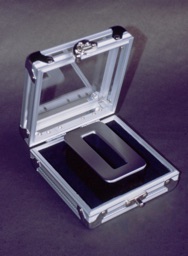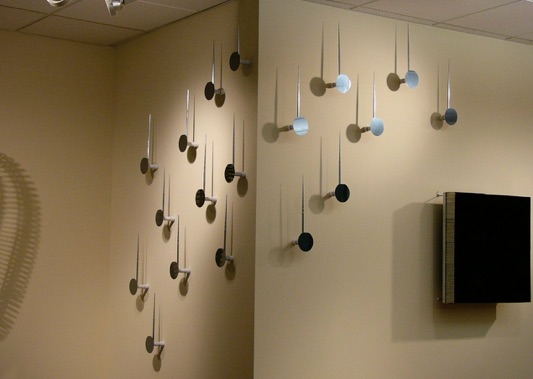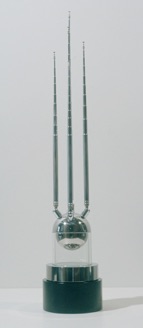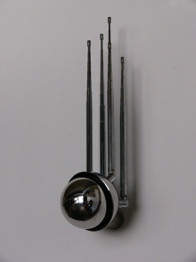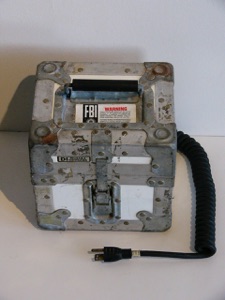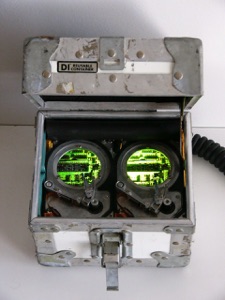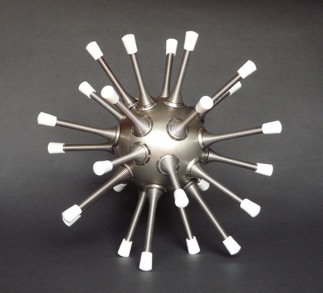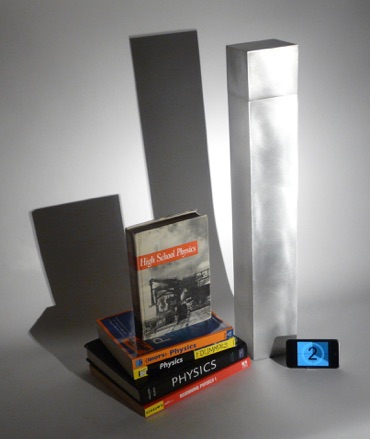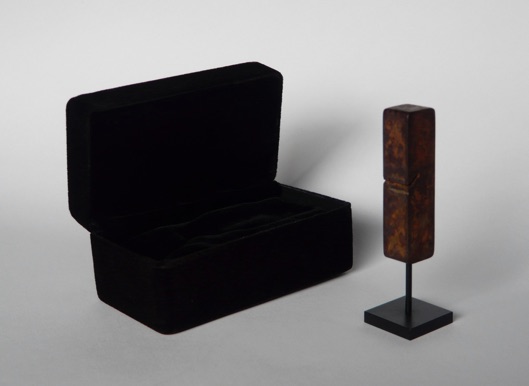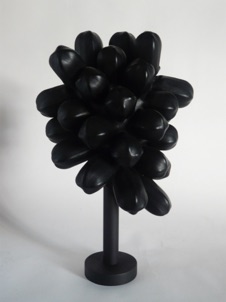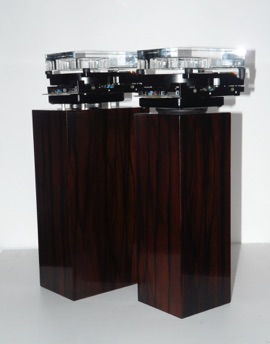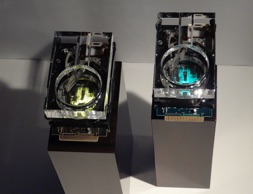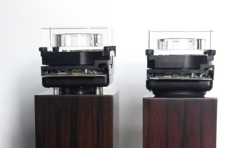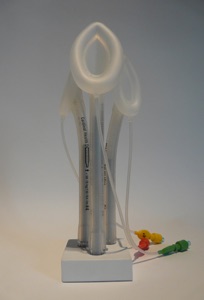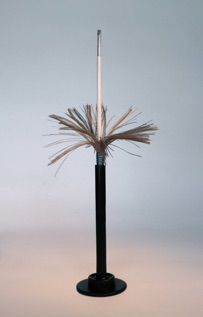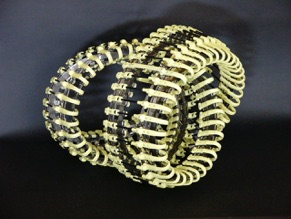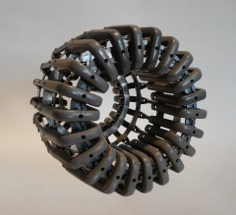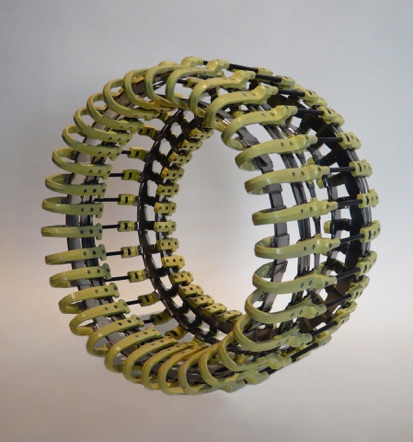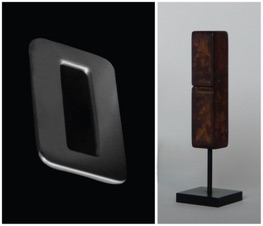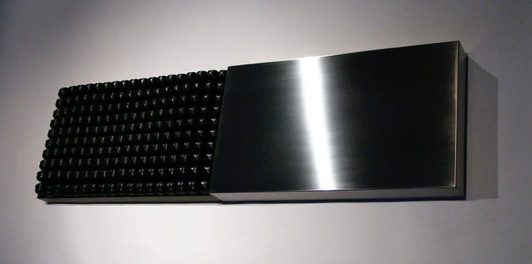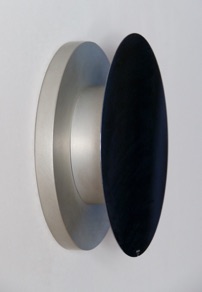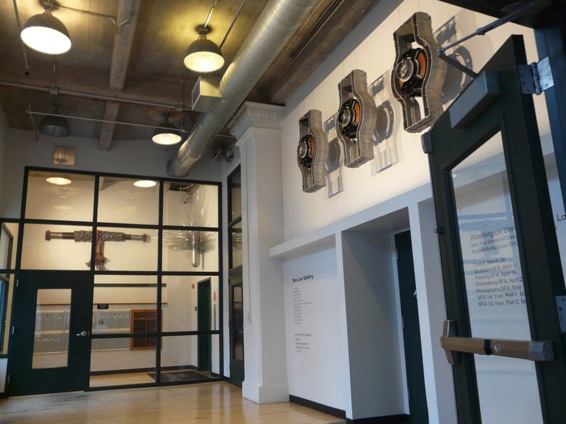Aspects of the Art
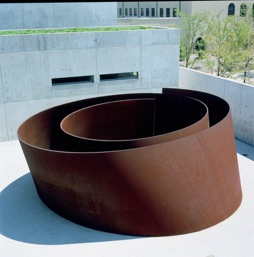
inside, joe (link), 2001, .06”H x 2.06”W x 3.5”D (cor-ten steel, wire) is located inside those windows above Joe at the Pulitzer Arts Foundation. This small, site-specific piece not only refers (or links) to the inside of Richard Serra’s wonderful Joe sculpture (deep beyond the cor-ten rust, the inner metal), but also to Joe Pulitzer’s love of art (his inside) which is fully shown in the arts foundation, that he and Emily created together.
Cross Shadow, 2007, 22’H x 15’W x 10’D (stainless steel, light, shadow) is a site-specific crucifixion feature that was commissioned by the Catholic Church (Chicago). It’s location is a circular garden columbarium with 5’ foot high walls, that allows the sculpture to cast cross shadows on the loved ones’ niches throughout the days and years. Rich symbolism relating to the Holy Trinity was achieved in the sculpture’s minimal design.
Gig (memories on walls), 2000, 40”H x 120”W x 12”D (computer hard drives, silicon wafers) is displayed at Washington University’s Des Lee Gallery and art-loft living facility in downtown Saint Louis. This piece employs one of the most basic elements of art, that of putting memories on walls...man has been doing that since the beginning of time…it is art. Here the artist does it at the dawn of the 21st century...the early part of the digital revolution. “These are corporate memories (mainframe)…a single gigabyte, weighing almost 400 lbs.”.
Note: The silicon wafer (a microchip’s foundational layer) is the physical place…the exact location and surface where we are now being completely transformed…a transformation that is having dramatic societal implications...as we all know, “The digital revolution is changing everything!” The microchip (or integrated circuit) is the engine driving the digital age.
Wired, 1993, 50”H x 109”W x 12”D (thermionic valves, wire) is currently displayed at Washington University’s Des Lee Gallery and art loft facility in downtown Saint Louis. Created from components of the first electronic computers (like Colossus & ENIAC), Wired provides a physical presence for our early notions of being “online” (remember those early dial-up modem sounds). Wired heralded the (www) digital age and its incredible transformational power...like an early signpost on the now archaic “Information Superhighway”.
Wireless (contact), 2000, 72”H x 100”W x 50”D (aerials, aluminum, stainless steel) is additionally located in Washington University’s (St. Louis) art & living facility, University Lofts. Aerials (visible ones) have significance since they are very close to being a thing of the past, while also being able to symbolize and give physicality to the incredible communications revolution the world is witnessing. Wireless communications have been around for sometime, but have had new significance in recent years and are now exploding throughout the entire world. This piece of artwork is also an “inter-active” and can dramatically change size and form (like communication networks today).
Wi-Fi, 2002, 48”H x 115”W x 3.5”D (computer chip silicon wafers, aerials) is similar to Wireless in that it also attempts to give physicality to the omnipresent yet ethereal digital networks, which surround us all today. Wi-Fi (wireless fidelity) and cellular devices are basically just silicon chips, aerials and power. Note: The number of nodes (units) varies from installation to installation. “Like notes in the air...the ones and zeros of binary code.”
Blackwhite, 2006, 19.5”H x 69”W x 4.5”D (stainless steel, inflatable roho) black & white, light & dark, occur often in Dotzler’s work…maybe it comes from the conclusions he has reached about our overall state of affairs (also consider the aim of Orwell’s Newspeak). The dark side of this artwork puffs up, just like the dark side in the real world (i.e. the Iraq “war”, U.S.A. torture & blatant deadly lies). It uses (inflatable) roho, a tech material known to those physically challenged. “Blackwhite” was exhibited at The Paraquad Show in St. Louis, an organization that supports the physically challenged (many, due to our imperialistic wars...also see this). This piece offers depth and a cool elegance, while also being playful and interactive at the same time.
telco, 2002, wireless world, 2001*, router, 2002, dimensions variable, (aerials, stainless steel, glass) are small “inter-actives” relating again to the communications revolution. They whisper of its ominous side...the omnipresent eyes of the corporate-government surveillance state and the ghastly hi-tech panopticon that is now fully in place and storing everything we do. (A panopticon -- literally “all-seeing” in the Greek -- is a prison where the guards can watch the prisoners without the latter knowing when they are doing it.) . These works can dramatically change size and form.
* Adam Aronson Collection. Presented in a special Zero Case w/ component pouches.
Feed (constant war), 2006, 45”H x 14”W x 16”D (machine‑gun belt feed)
Reload (vicious circle), 2010, 9.5”H x 9.5”W x 9”D (machine‑gun belt feed)
Reload (article - consider this too) are protest pieces Dotzler exhibited at Paraquad, an organization that offers support for paraplegics (and injured veterans) in the community. Spinal column injuries are prevalent among those served by Paraquad. One is a mobius strip (infinite loop) which allows for wall or surface installation with a shape that is flexible and interactive. vicious circle refers to the circular reasoning in politics and war. See: World Beyond War
evidence (memory box), 2000, 9”H x 9”W x 7.5”D (media box, computer hard drives, light, electrical cord) It has become a common practice by authorities in recent years to confiscate the computer hard drives of all persons of interest (taking their memories). This is significant when you consider that not too long ago an individual’s library records were private, respected and only made available to authorities in the most extreme cases. This piece is part of Dotzler’s memory box series.
"This artwork contemplates contemporary nomenclature,
relational dimensions and material societal issues."
“Joe” Richard Serra
“inside, joe” Mark Dotzler
hot, 1996, 48”H x 12”W x 11”D (thermionic valves, wire & cable) early piece based on the first computers and the elegance inherent in binary code and the digital revolution. Being single thought or memory driven is another theme conveyed by hard drive. “What we are witnessing now has already completely dwarfed the impact that the industrial revolution had on civilization...and this revolution is just beginning!”
dark fibre, 2012, 11”H x 4”W x 4”D (fibre-optic cable, steel) - wiki
hard drive, 1994, 34”H x 10”W x 10”D (hard drive, thermionic valves, metal, mask)
byte, 2008, 17”H x 74”W x 5”D (computer chip silicon wafer, titanium, steel spheres, chrome bulbs) is a piece of minimal code art (programable). It’s for simple beauty and a byte of code.
The Split, 2007, 26"H x 20"W x 18"D (aluminum, physics books, iPod running a countdown timer program, light, shadow) uses the shadow of a “High School Physics” book to represent World Trade Center, Building #7 that fell into its own footprint at free fall speed (6.6 seconds) on the afternoon of September 11, 2001. We were told that fire caused it to fall, but that is impossible and defies the basic Laws of Physics. The title, The Split, has a number of meanings here, but chiefly refers to a split in the seam of reality that occurred on 9/11. It also refers to the split in society...those who are aware and those who are not (some willfully so - like those in this TED Talk).
Reload (vicious circle), 2012, 13.5”H x 13.5”W x 8”D (machine‑gun belt feed) is related to the circular reasoning or logical fallacy in our disgusting and illegal resource and profit wars and “interventions”, torture and other blatant crimes against humanity, conspicuous murder and unjust monetary policies that promulgate havoc and discord throughout the world. See: World Beyond War
missing, joe (void), 2007, 3.25”H x .8”W x .8”D (cor-ten steel, stainless steel) is a companion piece to inside, joe that’s significant through both its minimal and relational aesthetics. This piece relates to the fact that Joe Pulitzer wasn’t there to experience the wonderful foundation for the arts that he and Emily had carefully planned for together and was sadly missing from the leadership desk that had been intended for him. [Another interesting aspect is related to technology in that the two pieces of artwork create a subtle 01...the binary essence of the digital age. The 01 also serves to commemorate the foundation’s 2001 opening.] This petite cor-ten steel sculpture is delightfully juxtaposed with Richard Serra’s huge one...just outside the window. Interesting possibilities are also offered when missing, joe is viewed as a maquette.
— Pulitzer Collection
BACKGROUND NOTES: missing, joe employs the cor-ten steel cut out left from the making of inside, joe which was then carefully weathered over several years prior to mounting.
It represents the void left through the loss of Joseph Pulitzer directly, but also symbolically, as corporate-state “managed” news became fully apparent, exposing mainstream media’s intentional and frightening loss of honesty, backbone, ethical standards and journalistic credibility. See: rare TV honesty / Totally Conrolled & here / Seymour Hersh / CNN related article / Presstitutes and here / Choice / Abby Martin / Orwell Rolls in his Grave / Murrow / Paul Craig Roberts / Bernays
BACKGROUND NOTE: On January 14, 2002 a small installation ceremony (subtly choreographed) took place in the President’s office of the Pulitzer Arts Foundation. On that day, a seemingly insignificant desk grommet was elevated to fine art and serves as a wonderful finishing touch for an incredible arts foundation.
flying heads, 2009, 16.5”H x 4.25”W x 7”D ea. (ebony veneer, mdf, computer hard drives, lead glass, MAG-LITE) Part of the memory box series. Note: Flying heads are the amazing little pads on the finger like devices in computer hard drives that read-write the 1s and 0s of binary code (see article).
“They could be made to accept the most flagrant violations of reality ... and were
not sufficiently interested in public events to notice what was happening.”
‒ George Orwell 1984
Start with the
attitude that the official story is risible and then reorient yourself to think about what really happened on 9/11.

segment detail
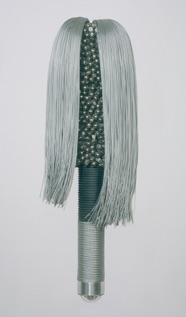
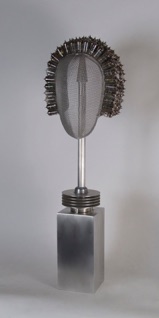
Washington University’s Des Lee Gallery
University Lofts, downtown Saint Louis
“HEY YOU” Remember the Bill of Rights?
Aldous Huxley Speaking at U.C. Berkeley in 1962 on The Ultimate Revolution
(consider mass surveillance, 9/11, controlled mass media & SSRI’s as you listen to Huxley)
“There will be, in the next generation or so, a pharmacological method of making people love their servitude, and producing dictatorship without tears, so to speak, producing a kind of painless concentration camp for entire societies, so that people will in fact have their liberties taken away from them, but will rather enjoy it, because they will be distracted from any desire to rebel by propaganda or brainwashing, or brainwashing enhanced by pharmacological methods. And this seems to be the final revolution.”
– Aldous Huxley
Is This Still America? When Truth is Suppressed Ignored Reality
©1993-2022 Mark Dotzler · all rights reserved
